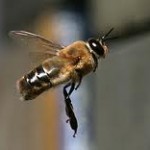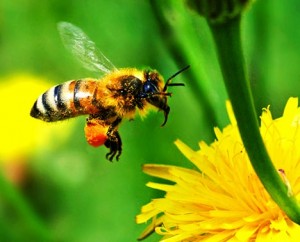 Male honey bees or drones, develop when the queen bee lays unfertilised eggs, although it is not really understood what triggers a queen to do this. Honey bee eggs hatch whether they are fertilised or not. As the drone is from an unfertilised egg, he has half the chromosomes of a worker bee, (16 rather than 32). It means that the drone has no father but does have a grandfather as his mother the queen was from a fertilised egg. This system of reproduction is known as parthenogenesis.
Male honey bees or drones, develop when the queen bee lays unfertilised eggs, although it is not really understood what triggers a queen to do this. Honey bee eggs hatch whether they are fertilised or not. As the drone is from an unfertilised egg, he has half the chromosomes of a worker bee, (16 rather than 32). It means that the drone has no father but does have a grandfather as his mother the queen was from a fertilised egg. This system of reproduction is known as parthenogenesis.
Drones are the largest bees in the honey bee colony and are usually to be found only during late spring and summer. While drones normally rely on workers for food, they can feed themselves within the hive after they are 4 days old, but are never to be found taking food from flowers themselves. Since drones eat three times as much food as workers, an excessive number of drones may place an added stress on the colony’s food supply. In autumn the female workers will attack them and chase them from the hive, to die outside, as to let them stay would be an unnecessary drain on the colony’s winter resources.
Drones stay in the hive until they are about 8 days old at which time they become sexually mature. They then begin to take orientation flights, these normally occur between noon and 4:00 p.m. The drone’s head is much larger than that of either the queen or worker and its compound eyes meet at the top of its head. These larger eyes are believed to help them spot the queens during mating flights. Drones have no stinger, pollen baskets or wax glands and their main function is to fertilise the virgin queen during her mating flight, but only a small number of drones manage to perform this function. Any drone who successfully mates will not return to his hive but will die on the wing, as his penis and connected abdominal tissues will be ripped from his body during mating.
Although drones perform no useful work for the hive, their presence is believed to be important for normal colony functioning however exactly why is not known.
You may also find the following of interest:
 Life and Easy Times of the Male Honey Bee A male honey bee or drone generally gets a bit of a bad press and women often like to highlight these poor creatures failings as being representative of the male gender in general.
Life and Easy Times of the Male Honey Bee A male honey bee or drone generally gets a bit of a bad press and women often like to highlight these poor creatures failings as being representative of the male gender in general.

